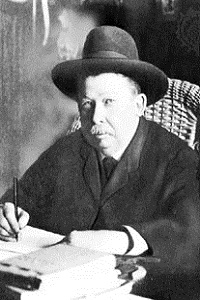
Joel Chandler Harris
Joel Chandler Harris (December 8, 1848—July 3, 1908) Born in Eatonton, Georgia, the only son of a respectable seamstress and an itinerant Irish laborer who left before he was born, “little Joe” Harris was a red-headed, freckle-faced boy who, though painfully shy (and perhaps ashamed of his illegitimacy), was known as quite a prankster nevertheless. At 16, Harris left home to become a printer’s apprentice at The Countryman, a literary newspaper published at Turnwold plantation, ten miles away. His employer, Joseph Addison Turner, allowed Harris full use of his extensive library and encouraged the youth’s writing. Harris also enjoyed the company of Turner’s slaves and listened attentively to their stories—many of which were African folk tales. After the Civil War, Harris worked as a journalist in Macon, New Orleans and Savannah, developing a wide reputation for his humor—especially one-line “filler” items reprinted throughout the South. He married Esther LaRose in 1876 and following an outbreak of Yellow Fever in Savannah, moved his young family to Atlanta where he and Henry W. Grady were hired as associate editors on the same day by The Atlanta Constitution. His Uncle Remus stories first appeared in the Constitution—Negro folk tales in authentic dialect and retold through the famous Negro character Uncle Remus. It is Brer Rabbit who is the hero of these stories. Harris openly dissented from racial views of his time and in these animal stories he was able to write with realism about things as they actually were. Brer Rabbit—living in a world populated by foxes, wolves, bears, and other powerful creatures. How he slyly and zestfully outwits his foes is more than a little suggestive of the black man’s situation in a society controlled and dominated by whites. Harris won international fame for his Uncle Remus tales. His fans included President Theodore Roosevelt and Mark Twain. However, the Remus stories represented only a small portion of Harris’s literary output. He was equally skilled in conveying a picture of the Georgia cracker, as seen in Mingo and Other Sketches (1884) and Free Joe and other Georgia Sketches (1887). He died at his home in west Atlanta which he called Snapbean Farm and lovingly renamed The Wrens Nest in honor of a pair of wrens who set up housekeeping in his mailbox—and whose privacy he respected and protected.
Brer Rabbit and the Tar Baby - Original Text
Brer Rabbit and the Tar Baby - Translated
Tales of Uncle Remus, Chapter 01
Tales of Uncle Remus, Chapter 02
Tales of Uncle Remus, Chapter 03
Tales of Uncle Remus, Chapter 04
Tales of Uncle Remus, Chapter 05
Tales of Uncle Remus, Chapter 06
Tales of Uncle Remus, Chapter 07
Tales of Uncle Remus, Chapter 08
Tales of Uncle Remus, Chapter 09
Tales of Uncle Remus, Chapter 10
Tales of Uncle Remus, Chapter 11
Tales of Uncle Remus, Chapter 12
Tales of Uncle Remus, Chapter 13
Tales of Uncle Remus, Chapter 14
Tales of Uncle Remus, Chapter 15
Tales of Uncle Remus, Chapter 16
Tales of Uncle Remus, Chapter 17
Tales of Uncle Remus, Chapter 18
Tales of Uncle Remus, Chapter 19
Tales of Uncle Remus, Chapter 20
Tales of Uncle Remus, Chapter 21
Tales of Uncle Remus, Chapter 22
Tales of Uncle Remus, Chapter 23
Tales of Uncle Remus, Chapter 24
Tales of Uncle Remus, Chapter 25
Tales of Uncle Remus, Chapter 26
Tales of Uncle Remus, Chapter 27
Tales of Uncle Remus, Chapter 28
Tales of Uncle Remus, Chapter 29
Tales of Uncle Remus, Chapter 30
Tales of Uncle Remus, Chapter 31
Tales of Uncle Remus, Chapter 32






